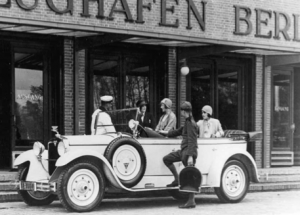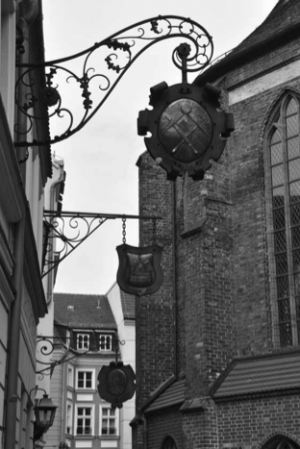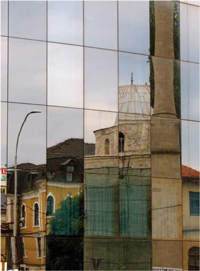
By Arthur Magida ’67
In The Nazi Séance, Arthur Magida chronicles the ascent of Erik Jan Hanussen, a Jewish psychic who became so popular in 1930s Berlin that he even rubbed elbows with high-ranking Nazis. In this excerpt, Hanussen returns to the colorful Berlin of the Weimar Republic after having his clairvoyant powers vindicated in a Czech court. It is the year before Hitler’s meteoric rise to power.
On May 28, 1932, the day after Hanussen’s victory in Leitmeritz, he boarded a train for Berlin. He was returning as the curtain was going up on the season which had thrilled Mark Twain. “Summer in Berlin,” Twain wrote, “is the perfection of the beautiful.” But Twain hadn’t been there since 1891, and the city had changed immensely. It was more elegant and cosmopolitan. Its streets, noted a Baedeker guide, were “a model of cleanliness,” its squares were “embellished with gardens, monuments and fountains,” its bridges were “beautified with sculpture.” Three quarters of the city’s buildings were “quite modern” and broad boulevards like the Lustgarten, the Opera Platz and the Linden were forming “magnificent thoroughfare[s] of the first rank.”
In 1920, Berlin absorbed seven towns, 59 villages and extensive landholdings that had been used exclusively by royalty, making it ten times the size of Paris. And it wasn’t shy about this, not in this age of nationalism and chauvinism. One newspaper headline blared in capital letters: we have 1.5 million more people than Paris; with 500,000 lines the city has the highest ratio of people to telephones. Another newspaper bragged: we have the fastest underground rail system in the world. And it was one of the cheapest: you could ride the system’s entire 452 miles for only 25 pfennings—half the price of a gallon of milk and 75 pfennings less than a pound of beef.
 The city was eminently livable. Berlin’s zoo was one of the best in Europe; its film theaters were the most up-to-date; and Luna Park, the city’s most popular amusement park, was mobbed on weekends and summer evenings. Most people went there to cool off on the park’s long water slide or to swim in the pool whose artificial waves were almost as large as those in the ocean. And once a week, the pool held Naked Day so Berliners could enjoy Germany’s new fascination with nudity.
The city was eminently livable. Berlin’s zoo was one of the best in Europe; its film theaters were the most up-to-date; and Luna Park, the city’s most popular amusement park, was mobbed on weekends and summer evenings. Most people went there to cool off on the park’s long water slide or to swim in the pool whose artificial waves were almost as large as those in the ocean. And once a week, the pool held Naked Day so Berliners could enjoy Germany’s new fascination with nudity.
Thousands of artists and writers were swarming to Berlin: Marc Chagall, Vladimir Nabokov, Christopher Isherwood, W. H. Auden, Paul Klee, Josef Albers—all of them working furiously by day, then talking late into the night at cafes like the Café des Westens, which—for obvious reasons—was nicknamed “The Megalomaniacs Café.”
With 45 theaters, dozens of concert halls, excellent conservatories and the most relaxed censorship laws in Europe, Berlin was the crossroads of high-brow, mid-brow and the avant-garde: Babylon and the Renaissance rolled into one.
But there were two Berlins, and the city’s days as a cauldron of creativity were numbered. In Before the Deluge, Otto Friedrich’s memoir about Berlin in the years leading up to the Second World War, he wisely and elegiacally writes that this was “a city unlike any other, we tell ourselves, not only because of what it was but because of the fate that lay before it. . . . We know that Berlin was a doomed city—as doomed as Pompeii—even at the height of its flowering under the benevolent glare of the Weimar eagle.” Away from the bright lights and the cafes and the artists’ garrets, Berlin was crumbling. The stone lions outside the palace at the end of the Unter den Linden were uncharacteristically quiet. The myth was that they roared whenever a virgin walked by, but it was hard to find a virgin
 in Berlin. As many as 100,000 whores were walking the streets. Many had moved to Berlin to be domestic servants, then realized that their wages didn’t allow them to live decently in the big city. Twenty-one thousand children were crippled. Forty-four thousand veterans, sick or maimed from the First World War, were begging in the streets. Thirty-five thousand women were widowed from the war. There was one murder every three days and over 50,000 burglaries, forgeries and swindles every year. Young girls barely into their teens were prostituting themselves after school with their parents’ permission.
in Berlin. As many as 100,000 whores were walking the streets. Many had moved to Berlin to be domestic servants, then realized that their wages didn’t allow them to live decently in the big city. Twenty-one thousand children were crippled. Forty-four thousand veterans, sick or maimed from the First World War, were begging in the streets. Thirty-five thousand women were widowed from the war. There was one murder every three days and over 50,000 burglaries, forgeries and swindles every year. Young girls barely into their teens were prostituting themselves after school with their parents’ permission.
The slums of Chicago, the gangsters of New York, the sorrows of Dickens’ London had descended on Berlin. Away from the late night discussions about art and politics and philosophy, Berlin was a symphony of pain. Inflation was so bad that housewives burned their worthless paper currency to heat their homes. One egg cost as much as 30 million eggs before the war. Almost every day, one more person used their entire savings for a tram ride to the other side of the city, where they threw themselves off a bridge. When Wall Street collapsed in 1929 and the Americans called in their German loans, unemployment tripled, then that number doubled. The country was tottering, torn between democrats, Communists and fascists, and Berlin, the capital, was crumbling under the never-ending and always worsening crises. New to democracy, which had begun only in 1918 when the Kaiser abdicated, the city—and the whole country—was breaking down.
This was Hanussen’s home. The cripples and the widows and the homeless didn’t know about him. If they had, they wouldn’t have cared. Life, for them, was too much of a grind. Rather, his audience was the people who enjoyed theater and spectacle and the avant-garde. And of course, much of his following would come from the same people who were attracted to the seers and the fortunetellers who had swarmed to Berlin after the armistice. Once the war was over, reason was given a vacation. The mind could think its way out of only so much misery. Throughout Europe, the lamentations for the dead and the maimed were loud. They were louder in Berlin, which is why so many practitioners of the psychic arts—20,000 by one count, up from 600 in 1900—flocked here. Hanussen knew this was his moment. What better place for him than Berlin, city of glitter, glitz and sorrow? Hanussen was many things, but he was never cautious. The troops from the right and the left were lining up. Hanussen didn’t care about that. He had left Leitmeritz a hero. It was time, he was sure, for the city to line up before him.
From The Nazi Séance by Arthur J. Magida. Copyright © 2011 by the author and reprinted by permission of Palgrave Macmillan, a division of Macmillan Publishers Ltd.
Arthur Magida is writer-in-residence at the University of Baltimore and a journalism professor at Georgetown University. His books, including The Rabbi and the Hit Man and Prophet of Rage: A Life of Louis Farrakhan and His Nation, can be found at www.arthurmagida.com.
The Art of Folkishness
Long before the extreme nationalism of the Third Reich, there was the more benign nationalism of the German folk movement in the early 19th century. For her Plan of Concentration in music, senior Rebecca Gildea is exploring the concept of “the folk” in German history, with all its nationalistic associations and impacts on music. “There are so many qualities and hidden meanings that are assumed when we talk about folk music, and those change every time you consider a different kind of folk music, whether ‘African,’ or ‘American,’ or ‘Hungarian,’” said Rebecca. “My Plan follows where these qualities and assumptions come from during the early folk movement in Germany, and how they were expressed and elaborated on in music.”

